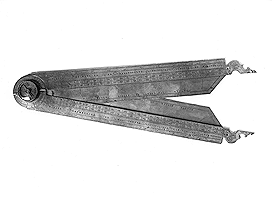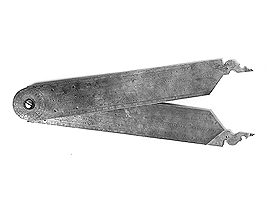 Fig. 23
Fig. 23  Fig. 24
Fig. 24
Signed: Tobias Volckmer. Sereniss: Ducis Bauarorum. &c: Mathe: & aurifaber faciebat. .1618.
The early English versions of the sector were oriented towards use in surveying and found military relevance chiefly through their sectoral or arc scales for polygons. Only the occasional addition of tables for gunnery suggested a more explicit warlike purpose (catalogue no. 2). However, an alternative design of the sector by Galileo was independently devised for more directly military needs. Galileo's sector was, in its early version of 1597, created to provide a combined quadrant and calculating instrument, able to take gunnery elevations and compute the weights and volumes of shot. He subsequently developed his sector into a more general-purpose device for computation, with gunnery just one element of its calculating repertoire. It was in this latter form that the instrument was published in an Italian edition of 1606. Wider European recognition began with a Latin plagiarism of 1607 and continued with a full Latin translation in 1612.
German authors and instrument makers were quick to adopt and adapt the Galilean sector. This instrument shows that by 1618 sectors quite distinct from the Galilean pattern in both construction and scales were being produced. The instrument's pairs of sectoral scales provide for volumetric reckoning and also the construction of polygons. In addition there are gunner's gauge scales for the familiar materials of iron, lead and stone, each graduated in Munich units. Amongst the instrument's other features is a quadrant scale graduated to give the angle between the two legs and a compass surrounded by scales of degrees and polygons. Each leg also carries a scale marked 'PVNCTA DIVISA. IN ARTHOLORIA. VTENDA.' which enables the instrument's points to be used as direct measuring calipers.
Length (closed): 356 mm
Inventory no. 38,366